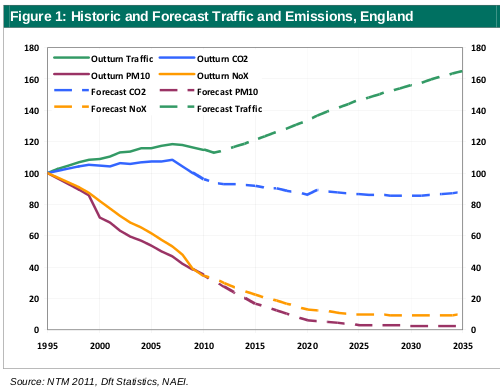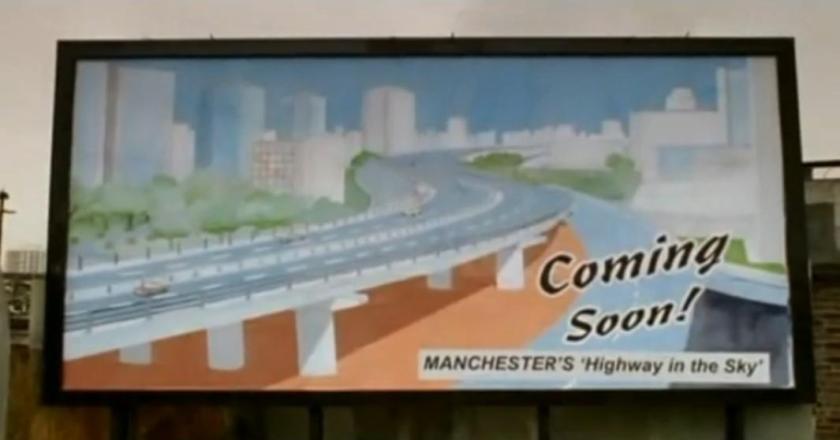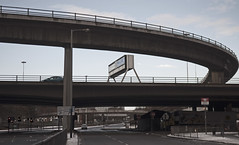I heard Radio 4 news report that the Games Lane™ on the M4 in west London came into force today and that there had been “no noticeable effect on the rest of the traffic”. Of course there was no effect on traffic: the Games Lane™ is just the old M4 bus lane, de-restricted in 2010 by the then new government. The bus lane was just an engineering hack, and abolishing it was always a pointless political gesture that could do nothing to help the Motorist. This seemed like a good excuse to re-publish this 2 year old post on why.
I rather let the announcement of the removal of the M4 bus lane pass without comment during the busy period, but with work commencing on painting over the lines, it seems a good moment to revisit the topic. Because while the M4 bus lane was never a remotely important feature of the national or local transport system, and the effect of its removal will be negligible, it has always been of huge symbolic significance.
The short stretch of bus lane at the inner-London end of the motorway was introduced in June 1999 by John Prescott — one of our best and most progressive transport secretaries (one of those non-achievements like “best British cycle route” or “most likeable cab driver”) — and was something new and difficult to understand. The government tried to explain how it would help everybody, how Motorists themselves would benefit from it, but all anybody heard was that the amount of concrete that Motorists could put their cars on was going to be reduced for the first time ever. The media were desperate for it to fail. What if it set a precedent? Take this fabulous rant from a BBC correspondent, in the days before BBC correspondents had their teeth filed for fear that they might be accused of anti-Tory bias.
The M4 bus lane was the symbol of the first government that had ever shown signs of recognising that the country has a dangerous car addition; the first ever road policy whose entire purpose was not to make it easier for more people to drive more cars further and faster. And in the tabloid media fantasy world, that amounted to a declaration of war on the motorist.
The irony is that the purpose of the M4 bus lane was not any different to any roads policy that had come before. It was introduced to smooth the traffic flow: to make journeys faster, easier and more reliable for motorists on the M4. The issue is explained with nice diagrams here. I won’t try to explain the whole thing in words (well, I did try, and failed, and deleted it), but the take home message is that the rate-limiting step for this section of the M4 is a bottleneck at Brentford that can never be eliminated. Where that bottleneck occurs, three lanes became two, causing merging and lane-changing throughout the three-lane section — behaviours which are known to slow overall traffic flow. By effectively making the M4 consistently two lanes wide, the bus lane is in fact a clever hack to make the traffic run more smoothly and reliably. It needn’t be a bus lane at all, it only needs for this section to be consistently two lanes wide instead of three lanes merging into two.
And it works. Despite having less space, and despite the reduction in speed-limit that coincided with the change in layout, journey times for all road users fell after the bus lane was introduced. (Only by seconds — it’s a very short stretch of road — but you know how much a second means to a Motorist.) And with less lane-changing, accident rates fell. Even the Daily Mail had to acknowledge that it had been a successful implementation of an evidence-based intervention for improving journey times, reliability, and safety.
But this was soon forgotten, because it just didn’t feel right. An empty lane that you’re not allowed to use doesn’t feel like it’s helping you when you’re stuck in a traffic jam, especially given the absurd rule that allowed rich businessmen to sail past in their taxis from the airport to the city (and still allows them to do this in most remaining London bus lanes). And the fact that it was a bus lane, not a hatched-out or fenced-off wasteland, seemed to make an important difference to many people — the AA took the bizarre stance that the lane’s success could only be measured in modal shift; that any other beneficial effect would be a failure. By the time Philip Hammond decreed that in the name of ending the War On The Motorist the lane must go and the road revert to three lanes, no journalist could remember it being anything other than Prescott’s folly, a joke on a road that is barely used by buses, and the cause of much Motorist misery. No journalist mentioned that it had once been hailed as a great success independent of its role as a bus lane. No journalist questioned the received wisdom that the bus lane was a stupid, pointless, unfair, in-your-face ideologically anti-Motorist waste of money.
The lane improved journey times by seconds. Removing it will probably worsen journey times by seconds. It will affect cabbies marginally more, and every few days the Motorists will close the road by smashing up their cars when changing lanes. It doesn’t matter; it never mattered. But installing it had the symbolic significance of suggesting that the government might, for once, now and then, just consider transport policies that go beyond Motorism; to occasionally provide for more than just the car user. Its removal is the symbol of the opposite stance: that this government will continue to provide for the car, and nobody else.
But more than that. By removing the M4 bus lane, Philip Hammond is telling us that this government will happily pursue policies that hit the Motorist, so long as they hit the non-Motorist harder. This is the deliberately spiteful act of a government that cares for dogma not evidence.










